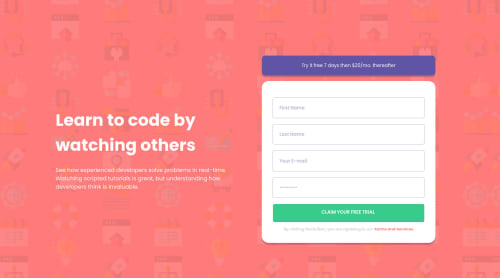Submitted over 3 years agoA solution to the Intro component with sign-up form challenge
Javascript form validation
@geoffreyhach

Solution retrospective
About the javascript form validation, is it the best practice to create a new function for every input like I did?
-I couldn't find how to add the svg icon in the input field, any suggestion? I tried to use a pseudo element on the error message span, but i couldn't position it like I wanted. EDIT : with the label elements that i forgot right?
-I did a desktop first version but I should have start with mobile I guess.
Code
Loading...
Please log in to post a comment
Log in with GitHubCommunity feedback
No feedback yet. Be the first to give feedback on geoffjecrois's solution.
Join our Discord community
Join thousands of Frontend Mentor community members taking the challenges, sharing resources, helping each other, and chatting about all things front-end!
Join our Discord